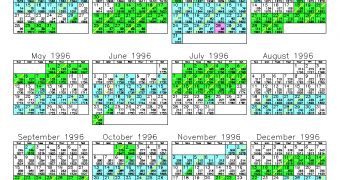The calendar gives us the temporal dimension. Without it, we could not register the succession of the events.
Calendars use three main notions: week, month and year. The last two originated in the observation of the astronomic events (the phases of the Moon and the Sun). The week was, at its origins, just a division of the month. The difficulty of comparing the duration of time is due to the fact that these units are not, one compared to another, matching multiples, fact that made all calendars to be affected by their lack of correlation, fact that imposed repeated corrections and adjustments.
The ancestor of the modern calendar is the Roman or solar calendar. Before being stabilized in 45 BC through a decree emitted by Julius Caesar, the Roman calendar experienced many variations. At its origins, it was made of 10 months: 4 of 31 days and 6 of 30 days, resulting a very short year, made of 304 days. The months January and February were added by Tarquinius and Numa, the 365 days being divided in 4 months of 31 days, 7 months of 29 days and one of 28. The first days of the months were the calends, the 5th and the 7th - the nones, and the 13th and the 15th - the ides.
Even so, the year was shorter than in reality, and the Romans introduced the intercalated months: one of 29 days at each two years. To adjust the discordance between the calendar and seasons, the Julian calendar used the calculations of the Greek astronomer Sosigene and was based on the adoption of a 365.25 days year: 3 years of 365 days followed by a 366 days year, the supplementary day being added always after the 24th of February (sexto ante calendas Martiis = the sixth day before the March calends) being called bis sexto (the sixth day bis), hence the names of bisect year and bisect day for the leap day. The year was divided in 12 months, which alternated 31 and 30 days and February had, in normal years, 29 days and 30 days in bisect years.
Later, when the eighth month was dedicated to the emperor Augustus (August), this month was made of 31 days to match July, the month dedicated to Julius Caesar. That's why February was made of 28 days, having 29 days in bisect years.
During the 16th century, the advance of the calendar was of 10 days compared to the real position of the Sun, and pope Gregorius XIII imposed the suppression of those days and a new reform. The Gregorian reform of passing from the 4th of October to 15 of October, in 1582, was subsequently adopted by all catholic states, then by the others, representing the current form of the calendar.
The average Gregorian year is of 365.2425 days, the plus compared to the astronomic year being of just 3 days at 10,000 years, which is acceptable. The Gregorian years starts, like in the Julian one, with the first day of January, just the date of the spring equinox (20 or 21 March) remaining variable (in the case of the bisect years). In what concerns the bisect years, to avoid a new future disparity, it was decided that the century years not to be bisect, except those dividing to 400: 1600, 2000, 2400...

 14 DAY TRIAL //
14 DAY TRIAL //